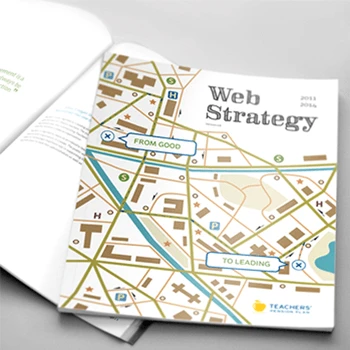What distinguishes content strategy from content marketing, and why does this matter for business results?
Content strategy provides the foundational framework that guides all content decisions, including what content to create, how to organize it, who manages it, and how it serves user needs throughout their entire experience lifecycle. Content marketing focuses on promotional content distribution, while content strategy encompasses the entire content ecosystem supporting your digital experience. Through our Experience Thinking approach, content strategy connects to brand expression, product interaction, and service delivery to create coherent user experiences rather than isolated content pieces. Strategic content planning considers user mental models, business objectives, technical constraints, and long-term sustainability. This comprehensive approach ensures content investment delivers measurable business outcomes through improved user satisfaction, reduced support costs, and enhanced competitive positioning.
Tip: Evaluate potential consultants based on their ability to connect content planning to broader business strategy rather than just content creation and publishing capabilities.
How does content strategy support digital transformation and organizational change initiatives?
Content strategy becomes the bridge between organizational knowledge and user experience during digital transformation by establishing governance frameworks, migration plans, and content architecture that supports both current needs and future growth. Our approach involves auditing existing content assets, mapping content workflows, establishing governance processes, and creating content systems that scale with organizational evolution. Content strategy addresses the challenge of moving from siloed, departmental content creation to unified, user-centered content experiences that support business transformation goals. We help organizations transition from ad-hoc content management to strategic content operations that reduce duplication, improve quality, and enable consistent brand expression across all touchpoints. This foundation supports broader digital transformation by ensuring content enhances rather than hinders user adoption of new systems and processes.
Tip: Include content strategy early in digital transformation planning rather than treating it as an afterthought to ensure content supports rather than complicates organizational change.
What role does foresight design play in creating future-ready content strategies?
Foresight design in content strategy involves anticipating how content consumption patterns, technology capabilities, and user expectations will evolve to create content frameworks that remain effective as conditions change. We analyze emerging trends in voice search, AI-powered personalization, cross-device experiences, and changing user behavior patterns to inform content planning decisions. Our forward-thinking approach considers how content will be discovered through AI search engines, how voice interfaces will change content consumption, and how personalization technology will affect content delivery. We also examine content lifecycle changes, emerging content formats, and evolving accessibility requirements that will impact content strategy over the next 3-5 years. This proactive approach helps organizations avoid costly content restructuring by building adaptable content systems that can evolve with technological advancement and user expectation changes.
Tip: Include discussion of your industry's future trends and technology adoption plans in content strategy development to ensure long-term strategic alignment and competitive advantage.
How do you align content strategy with broader user experience strategy through Experience Thinking?
Content strategy alignment with UX strategy requires understanding how content supports brand perception, product interaction, and service delivery across the complete user experience ecosystem. Our Experience Thinking framework ensures content planning considers how information architecture affects brand personality expression, how content quality influences product adoption, and how content accessibility impacts service effectiveness. We examine content touchpoints throughout the user lifecycle from awareness through advocacy, identifying how content needs change as users progress from prospects to customers to loyal advocates. This integrated approach connects content decisions to user research insights, business objectives, and technical capabilities. Content becomes a strategic asset that enhances every aspect of user experience rather than functioning as isolated information delivery. The result is content strategy that drives user engagement, supports business conversion goals, and creates sustainable competitive advantage.
Tip: Map your content needs against complete user journeys rather than individual touchpoints to identify content opportunities that support broader experience strategy goals.
What business outcomes can organizations expect from strategic content planning?
Strategic content planning delivers measurable business outcomes including increased user engagement, improved conversion rates, reduced content maintenance costs, enhanced SEO performance, and stronger brand consistency across all touchpoints. Organizations typically see 20-30% improvement in task completion rates when content is strategically organized around user mental models rather than internal organizational structure. Content governance frameworks reduce content creation time by 25-40% through clear processes, templates, and approval workflows. Strategic content architecture improves search performance through better content discoverability, semantic organization, and reduced duplicate content issues. Long-term benefits include decreased customer support volume through better self-service content, improved user onboarding success, and enhanced competitive positioning through superior content experiences that differentiate your organization from competitors who lack strategic content approaches.
Tip: Establish baseline metrics for current content performance including user engagement, task completion rates, and maintenance costs before strategic planning to accurately measure improvement ROI.
How does content strategy address the challenge of content at scale in large organizations?
Large-scale content strategy requires establishing governance frameworks, standardized processes, and content architecture that maintains quality and consistency across multiple content creators, departments, and business units. We create content governance models that define roles, responsibilities, approval workflows, and quality standards that scale across organizational complexity. Our approach includes developing content templates, style guides, and creation frameworks that enable distributed content creation while maintaining brand consistency and user experience quality. Content architecture planning considers how thousands of content pieces relate to each other, how users navigate complex information spaces, and how content maintenance scales sustainably over time. We also establish content performance measurement systems, automated quality monitoring, and governance communication strategies that keep large content operations aligned with strategic objectives.
Tip: Focus initial content strategy efforts on high-impact areas and proven processes before scaling governance frameworks across the entire organization to ensure sustainable implementation.
What's the relationship between content strategy and information architecture in digital experience design?
Content strategy and information architecture work together as complementary disciplines where content strategy defines what content serves user needs while information architecture determines how content is organized, labeled, and accessed by users. Content strategy informs IA decisions about categorization, navigation language, and content relationships based on user research and business objectives. Information architecture provides the structural framework that enables content strategy execution through logical organization, findable taxonomy, and intuitive navigation systems. Our Experience Thinking approach integrates both disciplines to ensure content organization supports brand expression, product discovery, and service effectiveness. The collaboration results in content systems where strategic content planning drives architectural decisions, while architectural constraints influence content planning to create realistic, sustainable content experiences that serve both user needs and business goals effectively.
Tip: Plan content strategy and information architecture development collaboratively rather than sequentially to ensure both strategic content goals and practical organizational needs are addressed effectively.
What does effective content governance look like, and how do you establish it in organizations?
Effective content governance establishes clear processes for content creation, review, approval, publication, and maintenance that ensure quality, consistency, and strategic alignment while enabling efficient content operations. Our governance framework development begins with mapping current content workflows, identifying stakeholder roles, and understanding approval processes across different content types and business functions. We create governance models that define content ownership, establish quality standards, and provide decision-making frameworks for content-related choices. Governance includes content retention policies, archiving procedures, and update schedules that prevent content decay and maintain relevance. The framework also addresses compliance requirements, brand consistency standards, and user experience quality measures. Implementation involves training stakeholders, establishing monitoring systems, and creating feedback loops that enable continuous governance improvement as organizational needs evolve.
Tip: Start governance development by documenting existing content creation processes and stakeholder roles before designing new frameworks to ensure realistic and adoptable governance structures.
How do you handle content governance across multiple departments, brands, or business units?
Multi-entity content governance requires establishing both centralized standards and distributed execution frameworks that balance consistency with local flexibility and business unit autonomy. We create governance hierarchies that define which content decisions require centralized approval and which can be managed locally while maintaining overall strategic alignment. Our approach includes developing shared content standards, brand guidelines, and quality criteria alongside local adaptation processes that respect business unit needs and market requirements. Governance structure addresses content sharing, asset reuse, and collaborative creation across organizational boundaries. We establish communication protocols, cross-functional review processes, and conflict resolution procedures that prevent content governance from becoming organizational bottleneck. The framework also includes performance monitoring and success measurement systems that track governance effectiveness across different organizational units.
Tip: Map decision-making authority and content ownership clearly across organizational boundaries to prevent governance conflicts and ensure accountability throughout distributed content operations.
What tools and technologies support content governance at enterprise scale?
Enterprise content governance leverages content management systems, workflow automation tools, digital asset management platforms, and analytics systems that enable governance execution, monitoring, and optimization across large-scale content operations. We evaluate content management platform capabilities including approval workflows, version control, access permissions, and automated governance enforcement features. Governance technology stack includes digital asset management for content reuse, brand compliance monitoring tools, and analytics platforms that track content performance and governance adherence. Our approach also considers integration requirements between content systems, marketing automation platforms, and business systems that affect content operations. Technology selection balances governance capability requirements with usability, implementation complexity, and total cost of ownership considerations to ensure sustainable governance execution.
Tip: Prioritize governance technology selection based on your organization's current tool adoption and change management capacity rather than just feature completeness to ensure successful implementation.
How do you establish content quality standards and measurement frameworks?
Content quality standards establish measurable criteria for accuracy, relevance, usability, accessibility, and brand consistency that guide content creation and review processes while enabling objective quality assessment. We develop quality frameworks that consider user needs, business objectives, technical requirements, and regulatory compliance to create practical quality standards that content creators can follow consistently. Quality measurement includes user feedback systems, content performance analytics, accessibility auditing, and periodic content reviews that identify quality issues before they impact user experience. Our approach establishes both automated quality monitoring for technical compliance and human review processes for content effectiveness, brand alignment, and user experience quality. Quality frameworks also include improvement processes, training recommendations, and quality trend analysis that enable continuous content quality enhancement across the organization.
Tip: Create specific, measurable quality criteria rather than subjective guidelines to enable consistent quality assessment and provide clear guidance for content creators and reviewers.
What's your approach to content lifecycle management and retention policies?
Content lifecycle management establishes systematic processes for content creation, maintenance, optimization, and archival that ensure content remains relevant, accurate, and valuable throughout its useful life while preventing content decay and organizational content debt. We develop lifecycle frameworks that define content review schedules, update triggers, performance thresholds, and archival criteria based on content type, business importance, and user behavior patterns. Lifecycle management includes automated monitoring systems that track content performance, identify outdated content, and alert stakeholders to maintenance needs. Our approach addresses content migration planning, legacy content assessment, and content consolidation strategies that prevent content proliferation without strategic purpose. Retention policies balance storage costs, legal requirements, and user needs to create sustainable content operations that maintain quality while controlling growth.
Tip: Establish automated content lifecycle monitoring from the beginning rather than trying to retrofit lifecycle management onto existing large content repositories.
How do you balance content governance structure with creative flexibility and innovation?
Effective content governance provides structured frameworks that enable rather than restrict creativity by establishing clear guidelines, efficient processes, and decision-making authority that reduces uncertainty while preserving space for innovation and creative excellence. Our governance approach distinguishes between elements requiring strict consistency like brand voice and legal compliance and areas where creative variation enhances user experience and business differentiation. We create governance frameworks that provide creative brief templates, brand guideline boundaries, and approval processes that support rather than slow creative development. Innovation spaces include experimental content formats, A/B testing protocols, and pilot project processes that allow creative exploration within risk-managed environments. The balance includes stakeholder education about governance value, creative team input in governance design, and regular governance evaluation to ensure frameworks evolve with creative needs and business requirements.
Tip: Include creative stakeholders in governance framework design to ensure processes support rather than hinder creative work while maintaining necessary quality and consistency standards.
What training and change management support content governance implementation?
Content governance implementation requires comprehensive training programs, change management strategies, and ongoing support systems that help stakeholders understand, adopt, and sustain governance practices across the organization. We develop role-specific training that addresses content creators, reviewers, managers, and technical stakeholders with relevant governance knowledge, tools usage, and process understanding. Change management includes stakeholder communication about governance benefits, pilot program implementation, and feedback collection that builds governance adoption momentum. Training programs address governance workflows, quality standards, tool usage, and decision-making frameworks through multiple learning formats including workshops, documentation, and hands-on practice sessions. Ongoing support includes governance champions, regular check-ins, process refinement, and success story sharing that maintains governance momentum and continuous improvement.
Tip: Plan governance training and change management as extensive programs rather than one-time events to ensure sustainable adoption and process improvement over time.
How do you approach content architecture design for complex, multi-audience websites?
Complex content architecture requires understanding diverse user mental models, task flows, and information needs to create organizational systems that serve multiple audiences without compromising usability for any user group. We conduct extensive user research including card sorting studies, user interviews, and task analysis to understand how different audiences categorize and access information. Our architecture approach creates flexible navigation systems, faceted content organization, and adaptive content presentation that allows different user types to find relevant information through their preferred pathways. Content architecture considers content relationships, cross-references, and progressive disclosure patterns that support both novice and expert users. The design balances organizational logic with user expectations while maintaining scalable structure that accommodates content growth and changing business needs over time.
Tip: Map content usage patterns across all user segments before designing architecture to identify shared navigation preferences and user-specific content organization needs.
What research methods inform your content architecture decisions?
Content architecture research combines card sorting studies, tree testing, user interviews, content audits, analytics analysis, and competitive benchmarking to understand user mental models, content performance, and optimization opportunities. Card sorting reveals how users naturally categorize content while tree testing validates navigation effectiveness before implementation. User interviews provide qualitative insights about information seeking behavior, content format preferences, and task completion strategies. Content audits identify existing content relationships, gaps, and opportunities for improvement. Analytics analysis reveals actual user pathways, popular content, and abandonment patterns that inform architecture optimization. We also conduct stakeholder interviews to understand business content goals and constraints. This multi-method approach ensures architecture decisions balance user needs with business objectives and technical feasibility.
Tip: Combine multiple research methods rather than relying solely on card sorting to gain comprehensive understanding of both user behavior and content performance patterns.
How do you handle content architecture for organizations with legacy content and complex migration needs?
Legacy content architecture requires systematic content auditing, migration planning, and architectural transition strategies that preserve valuable content while improving user experience and reducing content maintenance burden. We begin with comprehensive content inventory that assesses content relevance, accuracy, performance, and user value to inform migration priorities and content consolidation opportunities. Migration planning includes content mapping from old to new architecture, URL redirect strategies, and content transformation requirements for improved user experience. Our approach addresses content gap analysis, duplicate content elimination, and content format optimization during migration. Legacy integration considers SEO preservation, user behavior continuity, and stakeholder change management throughout transition process. We also establish content sunset procedures for outdated content and create governance frameworks that prevent future content decay and architectural degradation.
Tip: Prioritize content migration based on user impact and business value rather than trying to migrate all legacy content equally to maximize improvement while managing implementation complexity.
What's your approach to creating scalable content taxonomies and metadata schemas?
Scalable taxonomy development creates hierarchical content organization systems and metadata frameworks that accommodate business growth, content evolution, and user need changes while maintaining logical structure and findability. We design taxonomies based on user language patterns, business domain knowledge, and content relationship analysis to create intuitive classification systems. Taxonomy architecture includes controlled vocabularies, synonym management, and cross-reference systems that support both human navigation and automated content management. Metadata schema design considers content lifecycle requirements, search optimization, personalization capabilities, and integration needs with content management systems. Our approach balances specificity with flexibility to enable detailed content categorization without creating overly complex systems that become difficult to maintain. Implementation includes governance processes for taxonomy evolution, metadata quality maintenance, and stakeholder training for consistent application.
Tip: Start taxonomy development with core content categories and user tasks rather than trying to classify all possible content scenarios to create practical, maintainable classification systems.
How do you integrate content architecture with SEO and content discoverability requirements?
SEO-integrated content architecture creates information organization systems that support both user navigation and search engine understanding through semantic content relationships, logical URL structures, and content hierarchy that enhances organic search performance. We design architecture that supports keyword targeting, topic clustering, and content authority development while maintaining user-focused organization. Content structure includes internal linking strategies, content relationship modeling, and metadata frameworks that help search engines understand content context and relevance. Our approach considers technical SEO requirements including site speed, mobile optimization, and structured data implementation within content architecture planning. Integration also addresses content freshness, update frequency, and content lifecycle management that maintains search performance over time. The result is content architecture that enhances both user experience and search visibility through strategic information organization.
Tip: Align content architecture planning with keyword research and topic clustering strategies to create structure that supports both user navigation and search engine optimization goals.
What role does user testing play in content architecture validation?
User testing validates content architecture effectiveness through task-based evaluation, navigation assessment, and user feedback collection that identifies architecture strengths and optimization opportunities before full implementation. We conduct tree testing to evaluate navigation efficiency, first-click analysis to understand user pathway choices, and usability testing to assess overall architecture performance. Testing includes both moderated sessions for qualitative insights and unmoderated studies for broader user behavior patterns. Our validation approach tests architecture with representative users completing realistic tasks to identify navigation confusion, content findability issues, and user satisfaction problems. Testing results inform architecture refinement, labeling optimization, and structural adjustments that improve user experience before launch. Post-implementation testing provides ongoing architecture optimization data and user feedback for continuous improvement.
Tip: Plan architecture testing with realistic user tasks and representative participants rather than internal stakeholders to identify actual usability issues and navigation problems.
How do you design content architecture that supports personalization and adaptive content delivery?
Personalization-ready content architecture creates flexible content organization systems that enable customized content delivery while maintaining coherent navigation and user understanding across different personalized experiences. We design content models that separate content from presentation, enabling dynamic content assembly based on user preferences, behavior patterns, and contextual factors. Architecture includes metadata frameworks that support content filtering, recommendation engines, and audience segmentation while preserving content discoverability for non-personalized users. Our approach considers how personalization affects navigation consistency, content relationships, and user mental models to ensure customization enhances rather than confuses user experience. Integration planning addresses content management workflows, performance optimization, and governance processes that maintain content quality across personalized experiences. The result is content architecture that supports both browsing and personalized content consumption patterns.
Tip: Design content architecture with both personalized and standard navigation paths to ensure all users can access content effectively regardless of personalization system performance.
What does comprehensive content audit and analysis involve for strategic planning?
Comprehensive content audit systematically evaluates existing content assets for relevance, accuracy, performance, user value, and strategic alignment to inform content planning decisions and optimization priorities. Our audit process examines content quality through user task completion success, engagement metrics, search performance, and feedback analysis. Content analysis includes gap identification, duplication assessment, format effectiveness evaluation, and maintenance requirement analysis. We assess content against current user needs, business objectives, and competitive benchmarks to identify enhancement opportunities and sunset candidates. Audit methodology combines automated analysis tools with human evaluation to assess content accuracy, brand consistency, accessibility compliance, and user experience quality. Results inform content strategy including migration planning, creation priorities, optimization recommendations, and governance improvement opportunities that enhance overall content effectiveness and reduce maintenance burden.
Tip: Focus content audit effort on high-traffic and business-critical content first to identify quick wins and strategic opportunities before analyzing less important content assets.
How do you develop content creation workflows that scale across teams and departments?
Scalable content creation workflows establish standardized processes, role definitions, and collaboration frameworks that maintain content quality and consistency while enabling efficient distributed content production across organizational complexity. We design workflow frameworks that define content brief development, stakeholder input collection, creation responsibilities, review processes, and approval authority at each content production stage. Workflow planning includes template development, asset management, version control, and feedback integration processes that streamline content development while maintaining quality standards. Our approach addresses cross-departmental collaboration, subject matter expert involvement, and content creator support systems that enable sustainable content production. Implementation includes workflow documentation, training programs, and process optimization mechanisms that improve efficiency and quality over time. Technology integration supports workflow automation, progress tracking, and bottleneck identification.
Tip: Map existing content creation processes and stakeholder involvement patterns before designing new workflows to ensure practical and adoptable process improvements.
What's your approach to content gap analysis and content opportunity identification?
Content gap analysis systematically identifies missing content, inadequate content coverage, and content enhancement opportunities by comparing current content inventory against user needs, business objectives, and competitive benchmarks. We analyze user task flows, search queries, support requests, and feedback to identify content gaps that prevent task completion or create user frustration. Gap analysis includes competitive content assessment, industry best practice evaluation, and emerging content format opportunities that could improve user experience or business performance. Our methodology examines content depth, accuracy, currency, and format appropriateness across user journey stages to identify specific improvement opportunities. Analysis results inform content creation priorities, enhancement recommendations, and strategic content investment decisions that maximize user value and business impact. Implementation planning includes effort estimation, resource requirements, and success measurement for gap resolution initiatives.
Tip: Prioritize content gap analysis based on user impact and business value rather than attempting to identify all possible content improvements to focus resources on highest-impact opportunities.
How do you create content style guides and brand voice documentation that teams can actually use?
Practical content style guides provide clear, specific guidance for tone, voice, terminology, and formatting that enables consistent brand expression across distributed content creation while remaining usable for content creators with varying writing expertise. We develop style guides that include voice characteristics, tone variations for different contexts, terminology preferences, and writing patterns with specific examples rather than abstract guidelines. Documentation covers content structure, formatting standards, accessibility requirements, and legal compliance considerations that prevent common content issues. Our approach includes decision trees for style choices, quick reference materials, and template examples that support efficient content creation. Implementation involves training programs, style guide socialization, and feedback collection that ensures practical usage and continuous improvement. Integration with content workflows and review processes reinforces style guide adoption and consistency maintenance.
Tip: Create style guides with specific examples and practical decision-making tools rather than general guidelines to ensure content creators can apply brand voice consistently.
What role does competitive analysis play in content strategy development?
Competitive content analysis reveals industry standards, identifies differentiation opportunities, assesses user expectation benchmarks, and uncovers content innovation possibilities that inform strategic content planning and positioning decisions. We analyze competitor content strategies, information architecture approaches, content format usage, and user engagement patterns to understand competitive landscape and market opportunities. Analysis includes content quality assessment, coverage comparison, user experience evaluation, and content performance benchmarking where data is available. Our approach identifies content gaps in competitive offerings, successful content patterns worth adapting, and opportunities for content leadership through superior user experience. Competitive insights inform content positioning, format selection, quality standards, and innovation priorities that create competitive advantage through content excellence. Analysis results guide content investment decisions and help prioritize content improvements with highest market differentiation potential.
Tip: Focus competitive content analysis on organizations serving similar user needs rather than just direct business competitors to identify broader content innovation opportunities.
How do you establish content success metrics and performance measurement frameworks?
Content success measurement establishes metrics that connect content performance to user satisfaction and business objectives through tracking systems that enable data-driven content optimization and strategic decision-making. We develop measurement frameworks that include user engagement metrics, task completion rates, content findability indicators, and business impact measures like conversion rates and support cost reduction. Performance tracking combines quantitative analytics with qualitative feedback to understand both content usage patterns and user satisfaction with content effectiveness. Our approach establishes baseline measurements, benchmark comparisons, and improvement targets that guide content optimization priorities. Measurement systems include automated tracking, periodic review processes, and reporting frameworks that communicate content value to stakeholders. Success metrics inform content governance decisions, investment priorities, and continuous improvement initiatives that enhance content ROI.
Tip: Establish content performance baselines before implementing strategy changes to accurately measure improvement and demonstrate content strategy value to organizational stakeholders.
What's your process for content migration planning and execution?
Content migration planning systematically addresses content assessment, migration priorities, technical requirements, and timeline coordination to ensure successful content transition while minimizing user experience disruption and SEO impact. We develop migration strategies that evaluate content value, consolidation opportunities, and enhancement needs to optimize content portfolio during transition. Migration planning includes URL mapping, redirect strategies, content format updates, and quality improvement integration. Our process addresses stakeholder coordination, technical implementation requirements, testing protocols, and rollback procedures that manage migration risk. Execution includes content preparation, technical migration, quality assurance, and post-migration monitoring that ensures successful transition. Migration project management coordinates content teams, technical stakeholders, and business owners throughout process. Success measurement tracks migration completion, content performance, and user experience continuity.
Tip: Plan content migration as content improvement opportunity rather than simple content transfer to maximize strategic value from migration investment.
How do you establish sustainable content operations that maintain quality at scale?
Sustainable content operations combine systematic processes, governance frameworks, and performance monitoring that enable consistent content quality and strategic alignment as content volume and organizational complexity increase. We establish operations frameworks that define content production schedules, quality assurance processes, stakeholder coordination, and continuous improvement mechanisms. Operations planning includes resource allocation, workflow optimization, and scalability planning that accommodates growth without quality degradation. Our approach addresses content creator training, tool standardization, and collaboration protocols that maintain efficiency and consistency. Performance monitoring includes quality metrics tracking, process bottleneck identification, and user feedback integration that enables ongoing operations optimization. Sustainability considerations include workload management, stakeholder engagement, and technology evolution planning that maintains operational effectiveness over time.
Tip: Build content operations processes around your organization's current capabilities and growth trajectory rather than ideal-state scenarios to ensure realistic and sustainable implementation.
What tools and technology infrastructure support enterprise content operations?
Enterprise content operations require integrated technology stacks including content management systems, workflow automation, digital asset management, analytics platforms, and governance tools that enable efficient content production, distribution, and optimization at organizational scale. We evaluate technology requirements based on content volume, creator distribution, approval complexity, and integration needs with existing business systems. Technology architecture includes content creation tools, collaborative platforms, approval workflow systems, and performance monitoring capabilities that support content operations efficiency. Our approach considers user experience for content creators, technical scalability, security requirements, and total cost of ownership in technology selection. Implementation planning addresses system integration, data migration, training requirements, and change management that ensures successful technology adoption. Technology governance includes vendor management, system maintenance, and evolution planning that maintains operational effectiveness.
Tip: Prioritize content operations technology integration and user adoption over feature completeness to ensure sustainable technology usage and operational efficiency.
How do you manage content operations across multiple channels and touchpoints?
Multi-channel content operations establish centralized content strategy with distributed execution frameworks that maintain brand consistency and message coherence while adapting content for different channels, audiences, and consumption contexts. We create content operations that enable content reuse, adaptation, and optimization across web, mobile, social media, email, and emerging channels through systematic repurposing and channel-specific optimization processes. Operations planning includes content format libraries, adaptation guidelines, and channel performance monitoring that maximize content value across touchpoints. Our approach addresses content synchronization, version control, and update coordination that prevents channel inconsistencies and outdated content distribution. Cross-channel operations include shared asset management, coordinated content calendars, and unified performance measurement that optimize content effectiveness and operational efficiency.
Tip: Design content operations for content reuse and adaptation rather than channel-specific creation to maximize content investment and maintain consistency across touchpoints.
What's your approach to content localization and international content operations?
International content operations balance global brand consistency with local market adaptation through governance frameworks that define universal content standards alongside regional customization guidelines and localization workflows. We establish content operations that support translation management, cultural adaptation, local content creation, and regional approval processes while maintaining core brand messaging and user experience quality. Operations planning includes content prioritization for localization, translation workflow management, local content creator coordination, and cultural review processes. Our approach addresses content format adaptation, regulatory compliance requirements, and local user behavior considerations that affect content effectiveness. Technology infrastructure includes translation management systems, local content workflows, and cross-market content sharing capabilities. Performance measurement tracks content effectiveness across markets and cultural contexts.
Tip: Plan international content operations with local market input and cultural expertise rather than simply translating existing content to ensure cultural relevance and user experience effectiveness.
How do you handle content operations during organizational mergers, acquisitions, or restructuring?
Content operations during organizational change require systematic content consolidation, governance alignment, and process integration that preserves valuable content assets while establishing unified content strategies and operational frameworks. We assess existing content operations, identify consolidation opportunities, and develop integration plans that minimize disruption while optimizing content effectiveness. Change management includes content audit across organizations, stakeholder role clarification, and process harmonization that creates coherent content operations. Our approach addresses content migration, brand integration, and workflow consolidation challenges while maintaining content quality and user experience continuity. Implementation planning includes timeline coordination, resource allocation, and success measurement that ensures effective content operations integration. Long-term planning considers cultural integration, technology consolidation, and operational optimization that creates sustainable content operations.
Tip: Prioritize content operations integration planning early in organizational change processes to prevent content quality degradation and user experience disruption during transition periods.
What training and skill development support content operations effectiveness?
Content operations training develops stakeholder capabilities in content strategy understanding, creation skills, governance compliance, and tool proficiency that enable effective content operations execution and continuous improvement. We design training programs that address role-specific content responsibilities, strategic content thinking, quality standards, and collaborative workflow participation. Training includes content creation skills, editing techniques, governance process understanding, and technology tool usage through multiple learning formats. Our approach addresses both initial training for new stakeholders and ongoing professional development that maintains content operations effectiveness as requirements evolve. Skill development includes content strategy literacy, user experience awareness, and performance analysis capabilities that enable data-driven content decisions. Training effectiveness measurement includes skill assessment, performance improvement tracking, and feedback collection that guides training program optimization.
Tip: Design content operations training as ongoing professional development rather than one-time events to ensure stakeholder capabilities evolve with content operations requirements and technology advancement.
How do you measure and optimize content operations efficiency and effectiveness?
Content operations measurement tracks efficiency metrics like content production time, approval cycle duration, and resource utilization alongside effectiveness measures including content performance, user satisfaction, and business impact to enable data-driven operations optimization. We establish measurement frameworks that monitor workflow bottlenecks, quality indicators, stakeholder satisfaction, and strategic goal achievement through automated tracking and periodic assessment. Operations optimization includes process improvement identification, resource allocation adjustment, and technology utilization enhancement based on performance data analysis. Our approach addresses both short-term efficiency gains and long-term effectiveness improvements that enhance content operations value. Measurement systems include dashboard development, stakeholder reporting, and trend analysis that communicate operations performance and improvement opportunities. Optimization planning includes experimentation frameworks, change management, and success measurement that ensure sustainable operations enhancement.
Tip: Balance content operations efficiency metrics with effectiveness measures to ensure optimization efforts improve both operational performance and content strategy success.
How do you approach ongoing content optimization and performance improvement?
Ongoing content optimization establishes systematic review processes, performance monitoring, and improvement frameworks that enable continuous content enhancement based on user behavior data, feedback analysis, and business objective evolution. We create optimization programs that combine analytics review, user feedback collection, content performance assessment, and strategic goal alignment to identify improvement opportunities. Optimization methodology includes A/B testing protocols, content experiment design, and improvement measurement that validate optimization effectiveness. Our approach addresses content freshness maintenance, format optimization, accessibility improvement, and user experience enhancement through data-driven decision making. Implementation includes optimization workflow integration, stakeholder training, and process automation that sustains improvement efforts over time. Success measurement tracks optimization impact on user satisfaction, business outcomes, and strategic objectives.
Tip: Establish content optimization as regular operational activity rather than periodic project work to ensure continuous improvement and sustained content performance enhancement.
What role does user feedback and analytics play in content strategy refinement?
User feedback and analytics provide essential data for content strategy refinement by revealing actual user behavior patterns, content effectiveness, and optimization opportunities that inform strategic content decisions and improvement priorities. We integrate multiple feedback sources including direct user surveys, usage analytics, support request analysis, and user testing insights to understand content performance from user perspective. Analytics analysis includes content consumption patterns, user pathway analysis, engagement metrics, and conversion tracking that reveal content effectiveness and optimization opportunities. Our approach combines quantitative behavioral data with qualitative user feedback to understand both what users do and why they behave in specific ways. Insight integration informs content strategy adjustments, optimization priorities, and strategic planning refinements that improve content user experience and business impact. Regular analysis establishes feedback-driven improvement cycles that enhance content strategy effectiveness.
Tip: Combine multiple feedback sources and analytics platforms rather than relying on single data sources to gain comprehensive understanding of content performance and user experience quality.
How is AI transforming content strategy and what AI capabilities should organizations consider?
AI is revolutionizing content strategy through automated content generation, intelligent content optimization, personalization capabilities, and advanced analytics that enhance content effectiveness while reducing operational overhead. AI capabilities include automated content creation for routine updates, content performance prediction, personalized content delivery, and intelligent content categorization that scales content operations. We help organizations evaluate AI tools for content planning, creation assistance, quality monitoring, and performance optimization while maintaining human oversight for strategic decisions and creative excellence. AI integration considerations include content governance for AI-generated content, quality assurance processes, brand voice consistency, and ethical AI usage policies. Implementation planning addresses tool selection, workflow integration, staff training, and success measurement for AI-enhanced content operations. Strategic AI adoption balances automation efficiency with human creativity and strategic thinking.
Tip: Start AI integration with content analysis and optimization tasks rather than creative content generation to build confidence and understand AI capabilities before expanding usage.
What's your approach to content personalization strategy and implementation?
Content personalization strategy creates systematic approaches for delivering relevant content experiences based on user behavior, preferences, and contextual factors while maintaining content quality and operational efficiency. We develop personalization frameworks that segment users based on behavior patterns, demographic characteristics, and engagement history to deliver targeted content experiences. Implementation includes content tagging systems, recommendation engine integration, and dynamic content assembly that enables personalized experiences without compromising content governance or user privacy. Our approach balances personalization sophistication with implementation complexity and maintenance requirements to ensure sustainable personalization programs. Strategy includes personalization measurement, optimization protocols, and privacy compliance that enhance user experience while respecting user preferences and regulatory requirements. Technology planning addresses personalization platform integration, content management requirements, and performance monitoring.
Tip: Begin content personalization with simple user segment targeting rather than complex individual personalization to build capabilities and demonstrate value before advancing to sophisticated personalization.
How do you optimize content for voice search and emerging interaction modes?
Voice search optimization requires content strategy adaptation for conversational queries, natural language patterns, and audio consumption contexts that differ significantly from traditional text-based search and navigation behaviors. We optimize content for voice search through conversational keyword integration, question-based content formats, and structured data implementation that improves voice search discoverability. Content strategy includes answer-focused content creation, local search optimization, and featured snippet targeting that enhances voice search performance. Our approach addresses content format adaptation for audio consumption, including content structure optimization and natural language flow improvement. Implementation planning includes voice search analytics, performance monitoring, and optimization testing that measures voice search effectiveness. Future preparation considers emerging interaction modes including gesture control, AR interfaces, and IoT device integration that will affect content consumption patterns.
Tip: Focus voice search optimization on frequently asked questions and conversational content formats rather than trying to optimize all content for voice search to maximize impact efficiently.
What emerging content formats and technologies should organizations consider for future content strategy?
Emerging content formats including interactive content, video personalization, AR/VR experiences, and AI-generated content offer opportunities for enhanced user engagement and competitive differentiation through innovative content experiences. We evaluate emerging technologies based on user adoption trends, technical feasibility, and strategic alignment with business objectives to identify appropriate innovation opportunities. Format considerations include interactive infographics, personalized video content, immersive experiences, and automated content generation that enhance user experience and operational efficiency. Implementation planning addresses technical requirements, content creation workflow changes, and performance measurement for new content formats. Strategic planning balances innovation exploration with proven content format optimization to ensure sustainable content strategy evolution. Future readiness includes technology monitoring, experimentation frameworks, and adoption planning that position organizations for content innovation opportunities.
Tip: Experiment with emerging content formats through pilot projects rather than full-scale implementation to understand user response and operational requirements before major content strategy changes.
How do you ensure content strategy remains aligned with evolving business goals and market conditions?
Content strategy alignment requires regular strategy review, performance assessment, and adaptation planning that ensures content operations continue supporting business objectives as organizational goals and market conditions evolve. We establish strategy review processes that evaluate content performance against business metrics, assess competitive landscape changes, and identify strategy adjustment needs. Alignment methodology includes stakeholder feedback collection, business objective mapping, and content strategy impact assessment that inform strategy refinement decisions. Our approach addresses content strategy flexibility, adaptation protocols, and change management that enable strategic evolution without operational disruption. Implementation includes strategy monitoring systems, review schedules, and adjustment frameworks that maintain strategic relevance. Long-term planning considers market trend analysis, technology evolution, and business growth scenarios that affect content strategy requirements.
Tip: Schedule regular content strategy reviews tied to business planning cycles rather than waiting for performance issues to emerge to maintain proactive strategic alignment.












